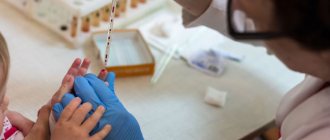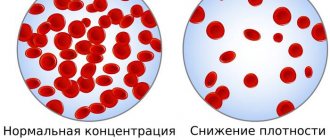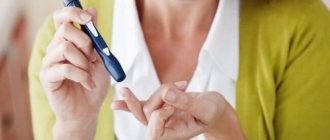Throughout the day, the level of glucose in the blood changes several times. The indicators are influenced by the qualitative and quantitative composition of food, physical activity, and neuropsychological state. The level of blood sugar after eating depends on the individual characteristics of carbohydrate metabolism. In older people, normative values shift upward due to an age-related decrease in cell sensitivity to insulin.
Some disturbances in the absorption of carbohydrates may occur in women during pregnancy and menopause. In a healthy person, ideal glucose levels after meals should not exceed 7.7 mmol/l (millimoles per liter - a unit of measurement of sugar). If the values are consistently elevated, diabetes mellitus or prediabetes is diagnosed. The prediabetic condition is characterized by the inability of body tissues to adequately absorb sugar, and glucose tolerance is impaired.
About glucose
Glucose is the main energy resource for the body and a source of nutrition for brain cells. Under the action of enzymes, food entering the intestines is broken down into individual components. Glucose molecules are formed from isolated saccharides and amino acids, most of which, after resorption (absorption) into the bloodstream, are transported to tissues and cells.
The role of the courier is played by the endocrine hormone of the pancreas - insulin. The liver converts the remaining unused sugar into glycogen (carbohydrate reserve). Whatever product the body processes, the level of glucose in the blood will increase. The degree of shift in sugar levels depends on the category of carbohydrates (simple or complex) present in the food eaten and the individual metabolic state of the person.
Objective data on glucose concentration (glycemia) can only be obtained by drawing blood on an empty stomach. In people with normal carbohydrate metabolism, the concentration of sugar in the blood relative to the internal environment of the body (homeostasis) remains at a stable level. When insulin sensitivity is impaired or insulin deficiency occurs, glucose accumulates in the blood, and cells and tissues remain “hungry.”
Who needs a glucose tolerance test?
If hyperglycemia is suspected, the doctor prescribes repeat tests. These are tests with a sugar load, allowing you to understand how ready the body is to cope with a one-time supply of glucose in large quantities. This is how the pancreas functions and its ability to produce insulin in large volumes is tested. Tests are carried out after consuming 75 g of glucose dissolved in water. Then the indicators are measured four more times with an interval of half an hour.
During pregnancy, this test is used to diagnose gestational diabetes. A glucose tolerance test is mandatory for all pregnant women at 24-28 weeks. For pregnant women in the risk category (history of gestational diabetes, body mass index more than 30), the test is performed earlier than these dates. It includes two stages of research, which are carried out on an empty stomach and after consuming glucose.
Sugar on an empty stomach
To determine glycemic values, capillary (from a finger) or venous blood is taken. In the second case, the figures may be slightly higher (within 12%). This is not a pathology. Before the study you must:
- Avoid drinking alcohol (three days before).
- Avoid food and oral hygiene in the morning (on the day of the test).
Important! If you prepare incorrectly on the eve of the analysis (sweets or alcohol for dinner, physical activity, nervous stress), the data may be distorted.
The results are assessed by comparing the obtained figures with standard values. Depending on the age category, the following fasting glucose levels are classified (in mmol/l):
| Children of preschool and school age | From puberty to 60 years | Elderly people up to 90 years old / 90+ |
| 3,3–5,6 | 4,1–5,9 | 4,6–6,4 / 4,6–6,7 |
For newborns and infants up to 3–4 weeks, the normative limits are 2.7 – 4.4 mmol/l. There are no differences in the laboratory examination results based on gender. With the exception of periods of changes in hormonal status in women (menopause, pregnancy). A prediabetic state is indicated by glycemic values on an empty stomach from 5.7 to 6.7 mmol/l.
In diabetics, glucose norms on an empty stomach are somewhat different, and determine the stage of the disease. Regulatory criteria for diabetic patients can be revised on an individual basis depending on the nature of the disease. You should not self-diagnose. To make a diagnosis of diabetes mellitus, it is necessary to undergo an extensive examination. A single discrepancy in sugar values does not 100% indicate the presence of pathology.
Indicators by age
Average acceptable blood glucose levels may vary due to a number of factors:
- age;
- general condition of the body;
- diet;
- human lifestyle.
When testing blood from a finger prick on an empty stomach, the following values are acceptable:
- children under 14 years of age - 2.3-3.9 mmol per liter;
- adolescents from 14 to 19 years old - 2.5-4.0 mmol per liter;
- adults 20-49 years old - 3.0-5.5 mmol per liter;
- patients over 50 years old - 3.5-6.5 mmol per liter.
If there are small deviations of a few tenths, this is acceptable.
Indicators after meals
Laboratory diagnostics of blood for sugar immediately after eating is not carried out. To obtain objective results, biological fluid is collected at one-hour, two-hour and three-hour intervals after meals. This is due to the biological reactions of the body. Active production of insulin begins 10 minutes after food and drinks enter the gastrointestinal tract (gastrointestinal tract). Glycemia reaches its maximum limit an hour after food intake.
Results of up to 8.9 mmol/l after 1 hour correspond to normal carbohydrate metabolism in an adult. In a child, values can reach 8 mmol/l, which is also normal. Then the sugar curve gradually moves in the opposite direction. When measured again (after 2-2 hours), in a healthy body, glucose levels drop to 7.8 mmol/l and below. After passing the three-hour period, glucose values should return to normal.
Note: The female body absorbs food faster and releases glucose. The consumption of incoming energy occurs more rapidly than in men. This explains the fact that there are more women with a sweet tooth than lovers of sweets among the male half of the population.
The main time reference for diagnosing prediabetes and diabetes mellitus is 2 hours. Impaired glucose tolerance is recorded at values from 7.8 to 11 mmol/l. Higher rates indicate the presence of type 1 or type 2 diabetes. Comparative sugar levels (in mmol/l) in healthy people and diabetics (regardless of gender) are presented in the table.
| Absence of illness | 1 type | Type 2 | |
| on an empty stomach | 3,3–5,6 | 7,8–9 | 7,8–9 |
| an hour after eating | up to 8.9 | until 11 | until 9 |
| two hours later | up to 7 | to 10 | up to 8.7 |
| in 3 hours | up to 5.7 | until 9 | up to 7.5 |
To determine the borderline state of prediabetes and as part of the diagnosis of the true disease, a GTT (glucose tolerance test) is performed. Testing includes double blood sampling (on an empty stomach and after a glucose “load”). In laboratory conditions, the load is an aqueous solution of glucose in the ratio of 200 ml of water and 75 ml of glucose.
For diabetics, the level of sugar after meals depends on the stage of progression of the disease. In a state of compensation, indicators are close to healthy values. Subcompensation of the disease is characterized by certain deviations, since it becomes more difficult to normalize glycemia. In the stage of decompensation, it is almost impossible to bring the indicators back to normal.
HbA1C stands for glycated (glycated) hemoglobin. It is the result of the interaction between glucose and hemoglobin (the protein component of red blood cells). Inside erythrocytes (red cells), hemoglobin does not change throughout their life, which is 120 days. Thus, based on the indicators of glycated hemoglobin, the glucose concentration is determined in retrospect, that is, over the past 4 months. This analysis is extremely important for diabetics and the primary diagnosis of the disease. Based on its results, the state of carbohydrate metabolism in the body is assessed.
Average HbA1C according to the age category of patients
| Norm | Permissible deviations | Excess |
| up to 40 years old | ||
| <6.5 | 6.5–7.0 | >7.0 |
| 45+ | ||
| <7.0 | 7.0–7.5 | >7.5 |
| 65+ | ||
| <7.5 | 7.5–8.0 | >8.0 |
How many times the glycemic level can change per day depends on diet, physical activity, and the stability of the psycho-emotional state. An increase occurs after each meal, during irrationally planned sports training (or excessive stress during physical labor), and during nervous stress. The lowest rate is recorded during night sleep.
How to determine glycemia
Sugar levels should be monitored at least once a year, even for healthy people. You can measure your level at home using a glucometer. The study should be carried out at different times of the day:
- On an empty stomach in the morning. Before the study, it is forbidden to take food and drinks except water for 8 hours.
- After meal. Control is carried out two hours after eating food.
Also, patients with diabetes are recommended to check their sugar levels several times during the course, especially in the first period after diagnosis.
Glucose solution
- Indicated for hypoglycemia, carbohydrate deficiency;
- For liver diseases, collapse, shock;
- To correct dehydration.
More details
THERE ARE CONTRAINDICATIONS. BEFORE USE, READ THE INSTRUCTIONS CAREFULLY OR CONSULT A DOCTOR
Differences between hyperglycemia after meals and on an empty stomach
Hyperglycemia is a pathological condition of the body in which the glucose level systematically exceeds the norm. If sugar levels do not return to normal within the allotted three-hour interval, it is necessary to be diagnosed with diabetes mellitus or prediabetes. The development of diabetes is considered the main cause of hyperglycemia. Other factors that influence abnormal sugar levels before and after meals include:
- chronic pancreatitis;
- hidden oncological diseases;
- increased synthesis of thyroid hormones (hyperthyroidism);
- incorrect hormonal therapy;
- chronic alcoholism;
- hypertension and atherosclerosis;
- deficiency of macro- and microelements and vitamins in the body;
- systematic physical overload;
- abuse of monosaccharides and disaccharides (simple carbohydrates);
- constant psycho-emotional stress (distress).
In the absence of disease, the minimum values are 3.9 mmol/l, from 2 to 4 am
The main reason for a stable increase in blood sugar and the development of diabetes is obesity. The main symptoms that may indicate hyperglycemia are:
- physical weakness, decreased ability to work and tone, quickly onset fatigue;
- dysania (sleep disorder), nervousness;
- polydipsia (permanent feeling of thirst);
- pollakiuria (frequent urge to urinate);
- systematic headaches, unstable blood pressure (blood pressure);
- polyphagia (increased appetite);
- hyperhidrosis (increased sweating).
Due to the weak functioning of the immune system, acute respiratory viral infections and colds become more frequent.
Blood sugar and type of diabetes
However, it is impossible to determine the type of diabetes (first or second) by the sugar level. The type of disease is not related to the result of the analysis, but to the causes of the pathology:
- Type 1 diabetes is the most severe form, occurring in 10% of cases. It is an insulin-dependent pathology, when the main cause is associated with insufficient secretion of the hormone insulin. Treatment is lifelong injections of this substance with constant monitoring of sugar.
- Type 2 diabetes is a less severe form and occurs in 90% of cases. This is acquired non-insulin-dependent diabetes. It is due to the fact that cells perceive insulin worse, which is why glucose does not penetrate into them and remains in the blood, which leads to an increase in levels.
Both forms of the disease are fraught with danger to the health and even life of the patient. If you do nothing, your health will worsen, which may lead to adverse consequences:
- destruction of blood vessels;
- serious metabolic disorder (ketoacidosis);
- heart attack;
- stroke;
- problems with vision and hearing;
- coma;
- limb amputation;
- bacterial and fungal skin infections;
- impotence.
Hypoglycemia before and after meals
Hypoglycemia is a forced decrease in glucose levels below the critical level of 3.0 mmol/l. At values of 2.8 mmol/l, a person loses consciousness. The reasons for the body's abnormal reaction after eating are:
How to measure sugar
- Prolonged refusal to eat (fasting).
- Strong emotional shock, often of a negative nature (stress).
- The presence of a hormonally active pancreatic tumor that synthesizes insulin in excess (insulinoma).
- Physical activity that is disproportionate to the body’s capabilities.
- Decompensated stage of chronic pathologies of the liver and kidneys.
Sugar levels decrease due to excessive uncontrolled consumption of alcoholic beverages. Ethanol has the property of inhibiting (blocking) the processes of food processing, the formation of glucose and its absorption into the systemic bloodstream. However, a person under the influence of alcohol may not experience acute symptoms.
When diabetes mellitus is diagnosed, the listed reasons are supplemented by incorrect insulin therapy for the first type of disease (unauthorized increase in insulin doses or lack of food intake after the injection), exceeding the prescribed dose of glucose-lowering medications (Maninil, Glimepiride, Glirid, Diabeton) in the second type of pathology. The state of reactive hypoglycemia is life-threatening.
Signs of lack of sugar in the blood: polyphagia, unstable psycho-emotional state (unreasonable anxiety, inadequate reactions to what is happening), autonomic failures (decreased memory, concentration), impaired thermoregulation (constantly cold limbs), rapid, rhythmic contractions of muscle fibers of the legs and arms (trembling or tremors), increased heart rate.
Energy deficiency is primarily manifested by low performance and physical endurance.
Who needs to measure glucose levels
Checking the level is necessary primarily for those who have been diagnosed with diabetes. Absolutely healthy people should also monitor their indicators. Medical examination is necessary when:
- Signs of hyperglycemia. They are manifested by fatigue, frequent urge to empty the bladder, a feeling of thirst, and weight changes.
- Being in a risk group. It includes people over forty years of age who have a genetic predisposition, are overweight, and have various stages of obesity.
- Pregnancy. Between 24 and 28 weeks, pregnant women may develop gestational diabetes mellitus.
Prevention of unstable glycemia in a healthy person
Normal blood sugar levels indicate the absence of carbohydrate metabolism disorders in the body. If the glucose level changes in one direction or another, you should resort to a number of preventive measures. This will help prevent (in some cases slow down) the development of pathological processes.
Preventive measures include:
- Changes in eating behavior. It is necessary to reconsider your diet and diet. Eliminate simple carbohydrates, fatty foods, fast food, and sweet carbonated drinks from the menu. Eat at least 5 times a day at equal intervals.
- Correction of physical activity. The load must correspond to physical capabilities. In addition, it is necessary to agree with your doctor which sports training is most suitable in each individual case (aerobic, interval, cardio, etc.).
- Refusal of drinking alcoholic beverages. The pancreas needs to be freed from alcohol load.
- Constant control over body weight (obesity leads to diabetes, anorexia can cause hypoglycemia).
- Regularly checking your sugar level (on an empty stomach and after meals).
- Strengthening the immune system. Hardening, systematic walks in the fresh air, course intake of vitamin and mineral complexes (before use, you must obtain consultation and approval from a doctor).
- Normalization of sleep. Night rest should be at least 7 hours (for an adult). You can eliminate dysania with the help of soothing decoctions and tinctures. If necessary, the doctor will prescribe medications.
Important! If you feel unwell, you should seek medical help. Simple fatigue can be a symptom of unstable glucose levels.
How to use a glucometer
The glucometer is easy to use. Some devices measure indicators in the blood, some in the blood plasma. This must be taken into account when calculating indicators.
The operating principle of the devices is the same:
- Wash your hands well before measuring your blood sugar. It is better to use warm water, which will help speed up blood circulation.
- The needle is released and the puncture depth is set on the lancet.
- The device is used to pierce the fingertip. Important! The puncture site should not be wiped with disinfectants; this may change the study data.
- A drop of capillary blood is applied to a special test strip. It is important that the area is completely filled with blood, otherwise the test will not be performed.
- After about 10 seconds, the sugar content appears on the display.
Devices may have an error of 10-15%. The most accurate indicators can be obtained from laboratory tests when collecting venous blood and plasma.
Indications for use
If a patient exhibits symptoms similar to the characteristic features of diabetes mellitus, the doctor prescribes a sugar test. These symptoms include:
- decreased visual acuity;
- decreased level of performance, feeling of frequent fatigue;
- feeling of constant thirst;
- feeling of dryness in the mouth;
- rapid weight loss;
- itching and dry skin;
- frequent urination;
It is also recommended to take the test once a year for people at risk. These include:
- patients who have relatives with diabetes in their family;
- overweight women, men and children;
- women who gave birth to a child weighing more than four kilograms;
- patients taking glucocorticosteroids;
- people with tumor diseases;
- men and women who were diagnosed with heart or vascular disease in middle age.
Pregnancy is also a reason to examine the amount of monosaccharides in the body, since during this period there may be cases of hidden diabetes.
Survey objectives
The analysis is intended to detect the presence of diseases of various origins, be it diabetes mellitus or the presence of a tumor. In addition to diagnostics, the analysis results are also used to prevent the occurrence of diseases. That is why this analysis is performed in completely different cases when an adult visits a doctor.
In addition, there are several types of blood glucose testing:
- General blood analysis. It is not the amount of sugar that is examined, but rather the emphasis is placed on the level of hemoglobin and blood clotting.
- Glucose tolerance test.
It takes about two hours:
- Initially, blood is taken before eating;
- then the subject drinks an average of 100 ml of sweetened syrup;
- Then blood is donated three more times: after an hour, 1.5 hours, and the last draw - after 2 hours.
If the pancreas is functioning normally, the glucose readings will be elevated during the first sampling, and will decrease with each subsequent result. This analysis is carried out when the purpose of the study is to identify prediabetes, as well as the possible presence of latent diabetes in a pregnant woman.
- Analysis for glycated hemoglobin. Shows hemoglobin, whose molecules interact with glucose. So, with an increased sugar content there will be more glycated hemoglobin.
- Also, the purpose of the study may include changes in glucose per day. With this method, the algorithm for changing a person’s sugar readings is controlled.
- There are situations when there is no time to wait to go to the clinic, and the analysis needs to be done quickly. In such cases, the express method is used. It is carried out using a glucometer. Mainly used to control sugar status in diabetic patients. The advantage of this method is that it is fast. Disadvantage - possible difference from the results obtained in a laboratory test.










